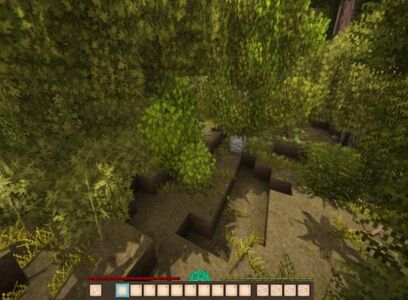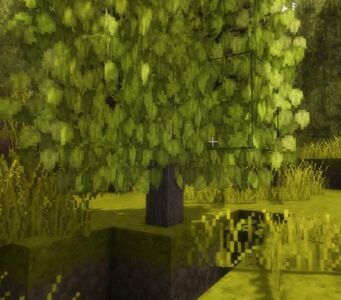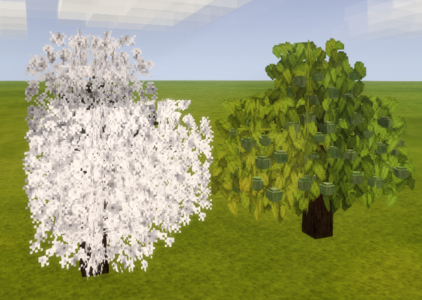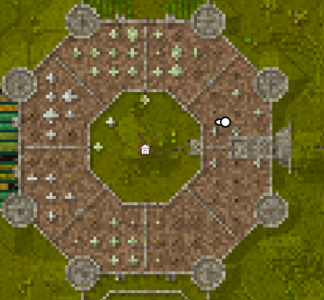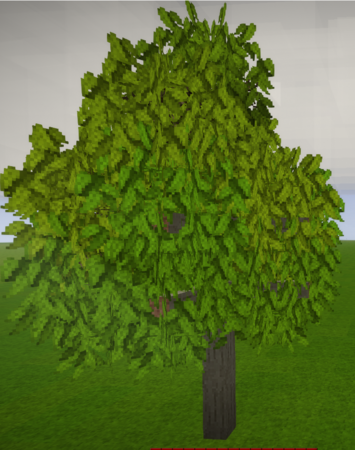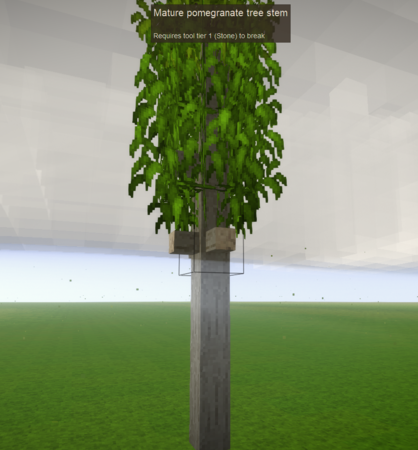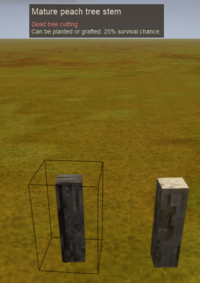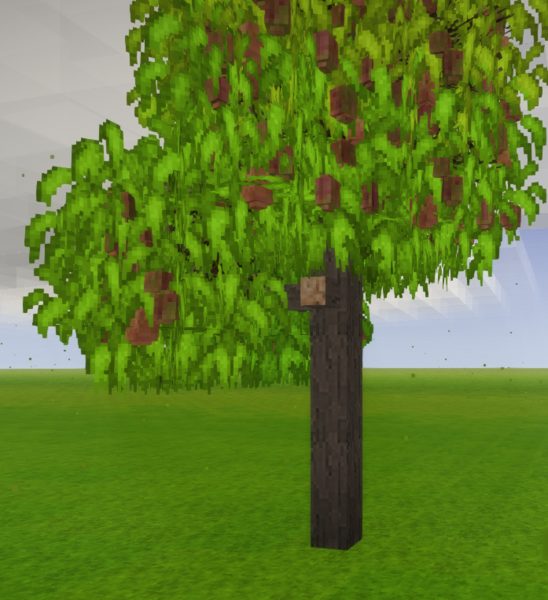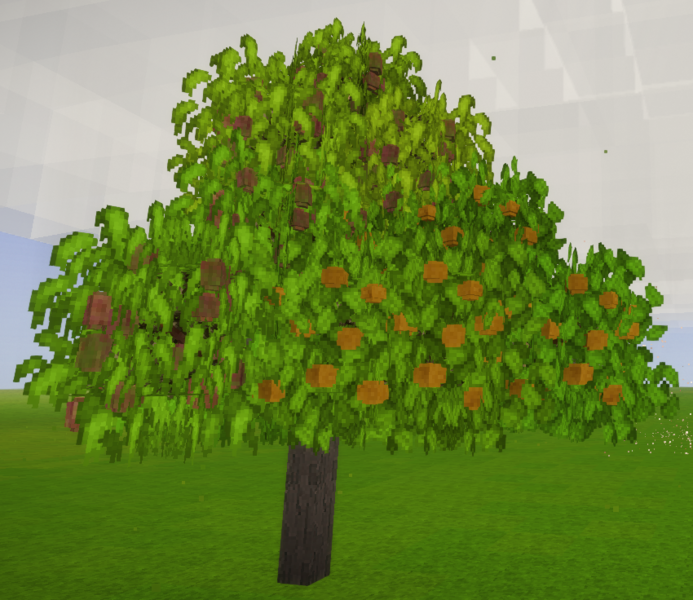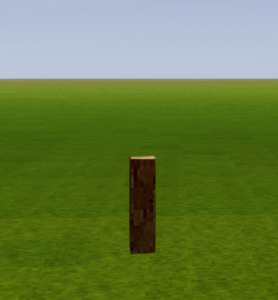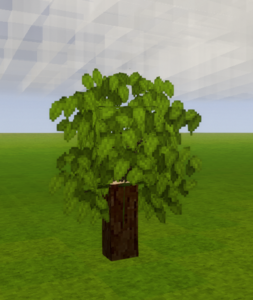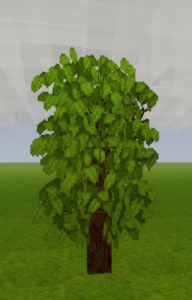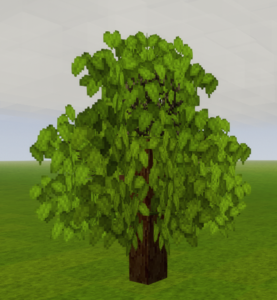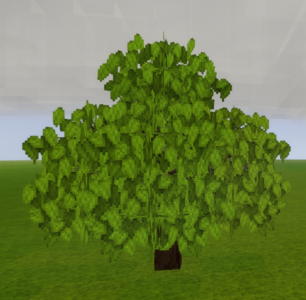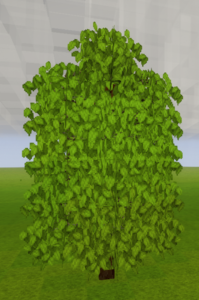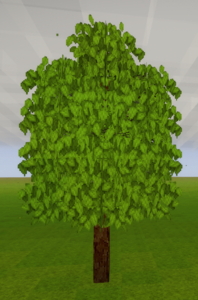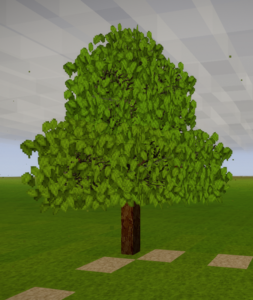Fruit tree
Fruit Trees are a separate kind of tree spawning in the world. Their foliage changes with the season like regular trees, however they will additionally go through 5 distinct stages from dormant to bearing ripe fruit. Their fruit can be harvested by the player to eat or turn into juice.
Finding Fruit Trees
Finding fruit trees in the wild can be a little challenging, unless they happen to be in their flowering phase. Since they are essentially just a different kind of tree, spotting them in a forest can be hard. They do however use different leaf block patterns and colours when compared to regular trees. The best signature for a fruit tree however is their trunk, since it is noticeably slimmer then the full block trunk of a regular tree.
Different fruit tree species require different temperatures and precipitation to spawn on world generation, and can therefore be found in different climates. Note that this does not take into consideration the extreme temperatures that can be reached in summer or winter, but instead depends on the yearly average temperature. This temperature can be shown when using the /wgen pos climate command - admin rights are required.
| Species | Min Temp | Max Temp | Min Rain | Max Rain |
|---|---|---|---|---|
| Red Apple | -5 | 18 | 0.5 | 1 |
| Pink Apple | -9 | 18 | 0.5 | 0.9 |
| Yellow Apple | 0 | 22 | 0.6 | 1 |
| Peach | 10 | 17 | 0.55 | 1 |
| Pear | -10 | 19 | 0.5 | 1 |
| Cherry | 0 | 24 | 0.6 | 1 |
| Orange | 25 | 30 | 0.45 | 1 |
| Olive | 22 | 50 | 0.3 | 0.5 |
| Mango | 28 | 50 | 0.6 | 1 |
| Breadfruit | 28 | 50 | 0.6 | 1 |
| Lychee | 22 | 50 | 0.6 | 1 |
| Pomegranate | 22 | 50 | 0.3 | 0.7 |
Collecting Fruit Tree Cuttings
Cuttings can only be acquired from the branch parts of a fruit tree, and will give 1 cutting for each branch part. They can only be broken with an axe.
A fruit tree consists of three different block types: tree stem, tree branch and tree leaves. While the stem only drops 3-7 firewood and the leaves do not drop anything when broken - unless they currently carry ripe fruit - only the tree branch blocks will drop fruit tree cuttings.
Currently, it appears that fruit trees unfortunately will not regrow if branch parts are cut off, however this might change in the future. To be on the safe side, the stem blocks should be left standing, since they do not drop cuttings anyhow.
Growing Fruit Trees
Fruit tree cuttings can either be planted in the ground for the chance of a completely new tree, or grafted onto an existing fruit tree. The chances for a cutting taking root and growing up is 40%, whereas a graft working out only has a 5% chance.
However, even if the cutting would take root, it can only do so if the temperature is accommodating for this specific fruit tree species.
The temperature under which a fruit tree will die can vary randomly within a certain amount, however one end of this temperature zone will be favoured. In the below list, the most likely temperature is shown first, with the full possibilities in brackets behind. Similarly, a fruit tree will go into dormancy under specific temperatures, which means even if it does not die, it will not be producing any fruit.
In the event that the tree survives and takes root, the temperatures need to stay within a certain range for an amount of time, for the tree to be able to flower - this is inspired by real life Vernalization.
That means, for a tree to flower, it needs to be exposed to the cold for a while and then experience a warm day. More specifically it needs to be exposed to temperatures above the die-below temperature but below 1.5 to 2.5 degrees (Vernalization Temp) for 220 to 280 in-game hours (Vernalization Time). It will then flower once the ambient temperature goes above 14 to 24 °C again.
| Species | Die-Below Temp | Vernalization Temp | Min Vernalization Time | Enter Dormancy Temp | Leave Dormancy Temp |
|---|---|---|---|---|---|
| Red Apple | -28 (-38 - -28) | 1.5 - 2.5 | 220 - 280 Hours | -3 (-7 - 1) | 19 (14 - 24) |
| Pink Apple | -24 (-34 - -24) | 1.5 - 2.5 | 220 - 280 Hours | -3 (-7 - 1) | 19 (14 - 24) |
| Yellow Apple | -22 (-32 - -22) | 1.5 - 2.5 | 220 - 280 Hours | -3 (-7 - 1) | 19 (14 - 24) |
| Peach | -12 (-22 - -12) | 1.5 - 2.5 | 220 - 280 Hours | -3 (-7 - 1) | 19 (14 - 24) |
| Pear | -28 (-41 - -28) | 1.5 - 2.5 | 220 - 280 Hours | -3 (-7 - 1) | 19 (14 - 24) |
| Cherry | -20 (-30 - -20) | 1.5 - 2.5 | 220 - 280 Hours | -3 (-7 - 1) | 19 (14 - 24) |
The following six tree species count as evergreen trees, therefore they do not have a specific flowering requirement, but are susceptible to low temperatures.
Please keep in mind that all information given may still change as fruit trees are currently still under development - specifically the given die-below and loose-leave temperatures given here are not final yet.
| Species | Die-Below Temp | Lose Leaves Below Temp | Blossoming Time? |
|---|---|---|---|
| Orange | 6 (1 - 6) | 3 (-1 - 3) | |
| Olive | 7 (2 - 7) | 0 (-4 - 0) | |
| Mango | 10 (6 - 10) | 3 (-1 - 3) | |
| Breadfruit | 10 (6 - 10) | 12 (8 - 12) | |
| Lychee | 10 (6 - 10) | 12 (8 - 12) | |
| Pomegranate | 10 (6 - 10) | 12 (8 - 12) |
Planting Fruit Trees
When planting a fruit tree cutting directly in the ground, each of the cuttings has a 40% chance to take root. However, if they are planted outside of their temperature comfort zone, where winter temperatures fall below their die-below temperature, they will not take root no matter what - or they might grow up only to die during the winter. It is recommended to check the temperature during winter - and specifically at night - before planting any fruit trees, to make sure the coldest reached temperature wont kill the fruit tree species that the player is planning to plant.
The soil used to plant the cutting in does not influence the survival chances nor the growth speed.
Grafting Fruit Trees
A fruit tree cutting can also be grafted to another, already grown fruit tree. However, this has some requirements and only a 5% chance of success.
Firstly and obviously, grafting only works on another fruit tree. It also requires the host tree to have an "open cut", meaning the end of a branch block as shown below. The new cutting can then be added to the branch and will grow out up to 6 additional leaf blocks of the added cuttings type. When planning your orchard keep in mind that through grafting, the maximum range of a fruit tree can therefore extend - from the normal two blocks out to a maximum of three blocks out from the stem.
A grafted cutting, even if successful, does not completely integrate with the host tree. It will keep the temperature requirements of its own type, and every leaf block calculates these independently. This results in an important point to keep in mind when preparing and caring for a graft:
Do not attempt to graft fruit trees together that have highly differing temperature requirements. In the best case scenario it would simply look silly, as the different parts of the tree would very likely circle through the flowering and fruiting at different times - in the worst case scenario however it would not work out in the first place or the tree would have a permanently dormant branch.
Greenhouse
Fruit trees can be planted in greenhouses, however the +5°C effect will only apply to the vernalization temperature. The "die below" temperature will not be effected.
Given that one fruit tree will grow exactly 6 blocks tall and can, ungrafted, be up to 5 blocks wide - up to 2 away from the stem - only one fruit tree can be accommodated in each greenhouse.
Growth Stages
Fruit trees will go through several stages of growth until they reach their maximum height of 6 (possibly 8) blocks and maximum width of 5 blocks. Growth stages and the time between them are the same for all fruit tree species. They will simultaneously go through their seasonal changes as well, however those two do not influence each other - as long as the fruit tree has leaf and/or branch blocks, those can flower and bear fruit. However, leaf blocks that have not flowered and only grow while the rest of the tree is already in the fruiting or ripe phase will not adapt to the same seasonal stage and instead stay plain.
It takes on average 8 days until the next growth stage is reached, however it can - very rarely - take less or more time, from 6 to a maximum of 10 days.
A growth stage can either be an upwards or sideways growth. This means the tree will cycle through growing one block taller and then adding additional leaf blocks until the full "volume" for the current height is reached. The last few growth stages are different from this cycle, since once the tree has reached its maximum height, it will instead concentrate on only growing sideways until it has again filled its maximum "volume".
It is important to not that fruit trees may go through these stages differently - the red apple tree used in the below example went through a total of 14-16 stages (including growth of filler leaves) and gained the full possible volume. However, fruit trees may skip some of the four directions while growing or even end up in their maximum growth with one half having grown "stunted" - meaning a branch block missing and therefore not reaching the full possible width. They will however, without fail, all reach their maximum possible height.
Seasonal Changes
Different fruit tree species circle through the 5 different stages from dormant to ripe, following the seasons and each trees temperature requirements. Specifically the stages fruiting and ripe may be hard to spot for some species, it's recommended to enlarge the picture to get a better look.
The stages flowering, fruiting and ripe only stay for a certain amount of days - the block info tooltip for the leaf blocks will include a timer until the end of the current stage. This is especially important for the ripe stage, since the fruits will vanish after the end of the stage if they are not picked up in time.
| Tree | Length of Stage in days |
Dormant | Plain | Flowering | Fruiting | Ripe |
|---|---|---|---|---|---|---|
| Red Apple | Flowering: 3-6 Fruiting: 18 (18-39) Ripe: 12 (12-22) |
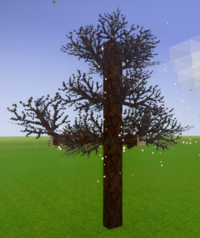
|
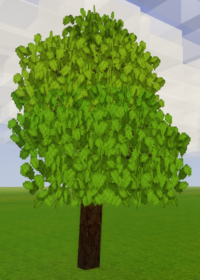
|
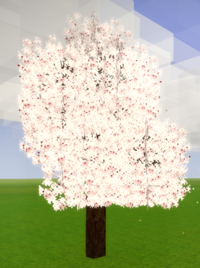
|
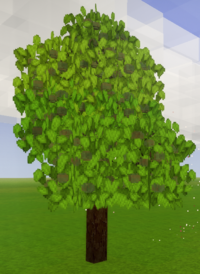
|
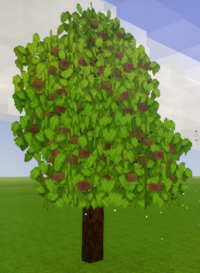
|
| Pink Apple | Flowering: 3-6 Fruiting: 21 (21-33) Ripe: 9 (9-19) |
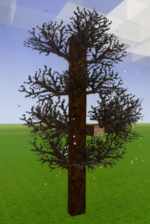
|
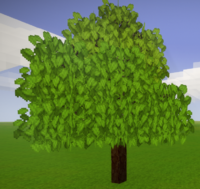
|
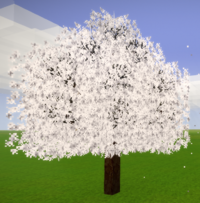
|
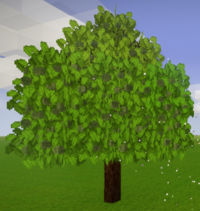
|
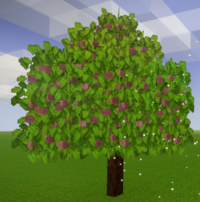
|
| Yellow Apple | Flowering: 3-6 Fruiting: 23 (23-35) Ripe: 10 (10-20) |
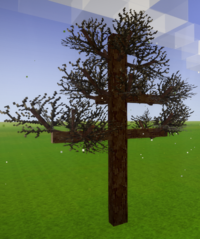
|
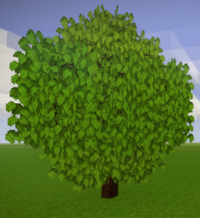
|
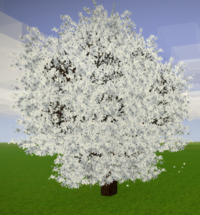
|
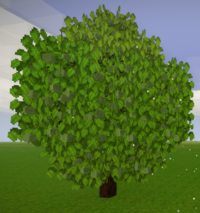
|
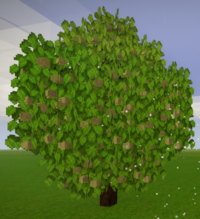
|
| Peach | Flowering: 3-6 Fruiting: 30 (30-42) Ripe: 8 (8-16) |
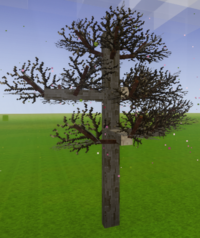
|
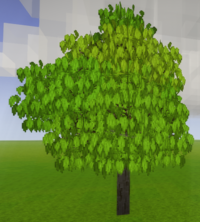
|
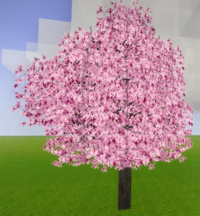
|
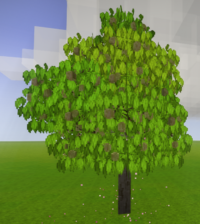
|
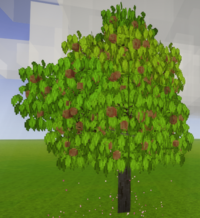
|
| Pear | Flowering: 3-6 Fruiting: 20 (20-32) Ripe: 28 (28-38) |
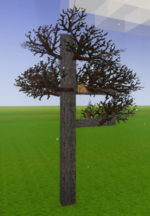
|
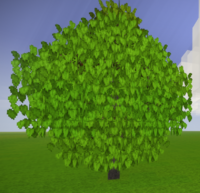
|
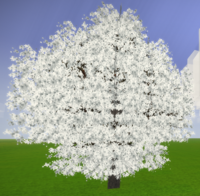
|
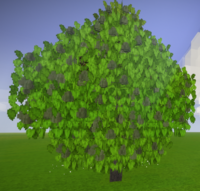
|
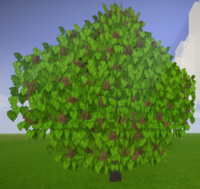
|
| Cherry | Flowering: 3-6 Fruiting: 11 (11-23) Ripe: 9 (9-19) |
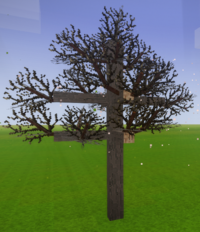
|
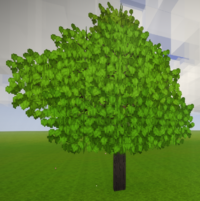
|
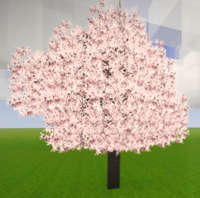
|
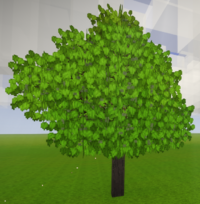
|
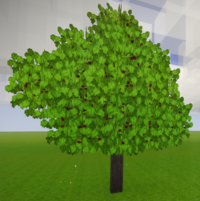
|
| Orange | Flowering: 3-6 Fruiting: 60 (60-72) Ripe: 12 (12-22) |
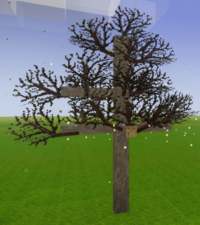
|
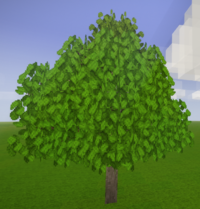
|
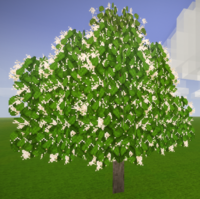
|
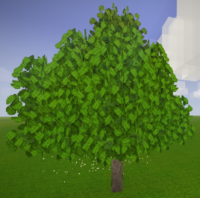
|
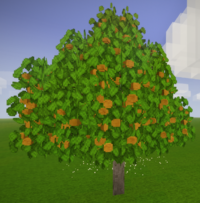
|
| Olive | Flowering: 3-6 Fruiting: 40 (40-52) Ripe: 24 (24-34) |
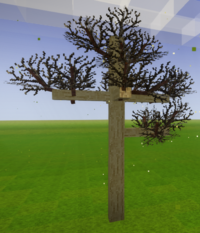
|
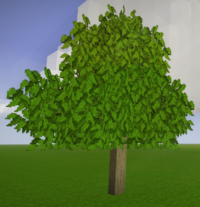
|
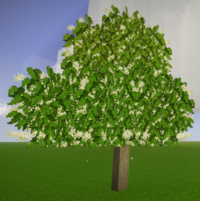
|
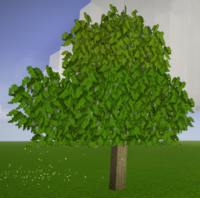
|
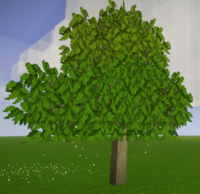
|
| Mango | Flowering: 3-6 Fruiting: 50 (50-62) Ripe: 10 (10-20) |
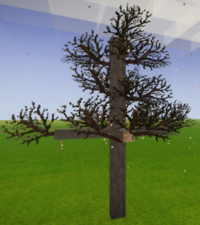
|
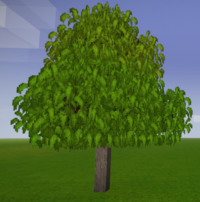
|
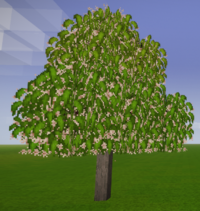
|
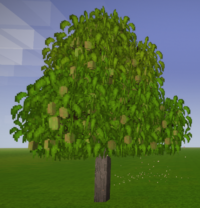
|
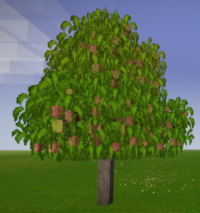
|
| Breadfruit | Flowering: 3-6 Fruiting: 50 (50-62) Ripe: 10 (10-20) |
- | 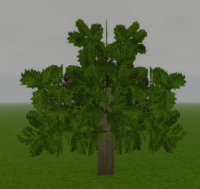
|
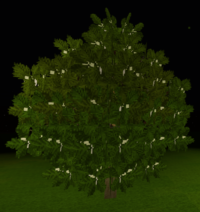
|
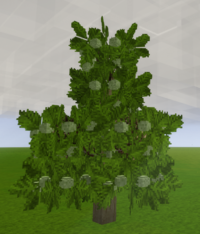
|
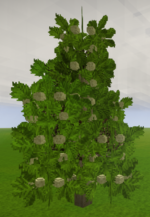
|
| Lychee | Flowering: 3-6 Fruiting: 50 (50-62) Ripe: 10 (10-20) |
- | 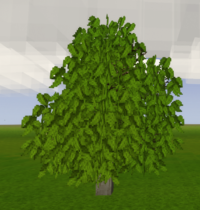
|
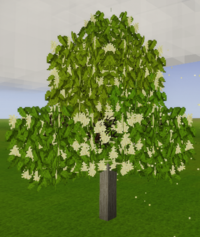
|
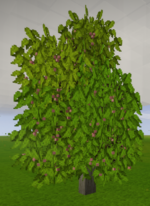
|
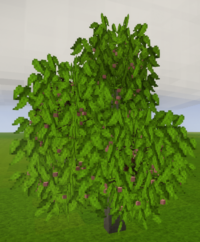
|
| Pomegranate | Flowering: 3-6 Fruiting: 50 (50-62) Ripe: 10 (10-20) |
- | 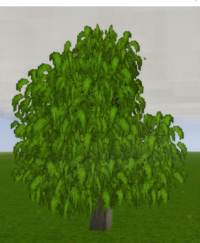
|
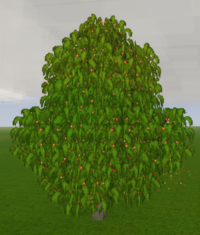
|
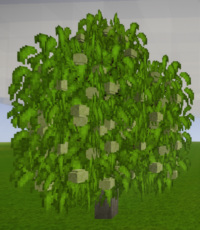
|
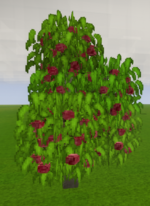
|
- Unfortunately the flowering phase for this Breadfruit tree fell in between 3-4 am and was over before daylight. Will be changed with a better picture if possible.
Harvest
Fruit can be
harvested from the leaf blocks titled "with ripe fruit". A specified amount of fruits will be deposited directly into the inventory, leaving the plain leafs behind to go through the flowering cycle again. Harvesting fruit trees in this manner takes a little bit longer then harvesting a berry bush, the right button needs to be held down for about a full second. Leaf blocks ripe with fruit will also drop their fruit if broken, however as of now they do not grow back.
Each leaf block can be harvested for a randomized number of fruit, as shown below as Harvest Stack Size. The first number is the most likely outcome, however there is a low chance to gain more, as detailed in the brackets.
| Farming | |
|---|---|
| Wild foods | Berries • Cactus (saguaro) fruit • Mushrooms • Cattail (and papyrus) |
| Grains | Amaranth • Cassava • Flax • Rice • Rye • Spelt • Sunflower |
| Vegetables | Cabbage • Carrot • Onion • Turnip • Parsnip • Peanut • Pumpkin • Soybean |
| Fruits | Fruit trees • Pineapple |
| Other | Fertilizer • Beekeeping • Room |
| Tools | Hoe • Scythe • Fruit press |
| See also | Animal husbandry • Cooking • Food preservation |
| {{{title}}} | |
|---|---|
